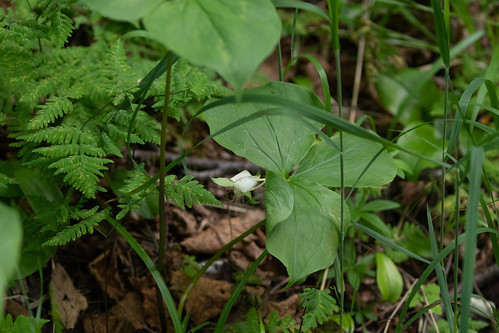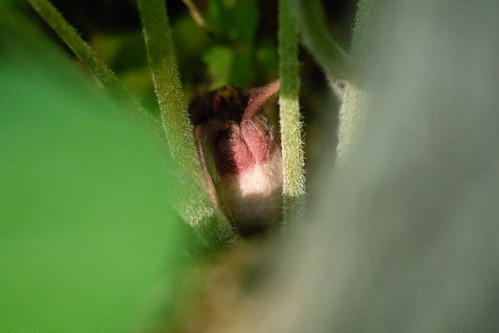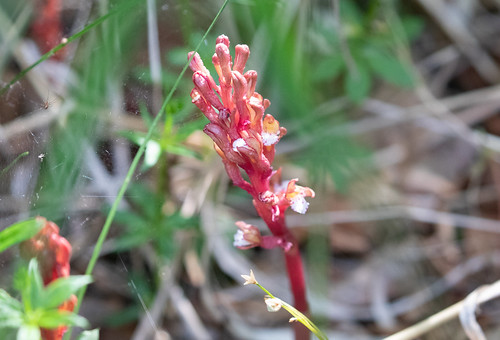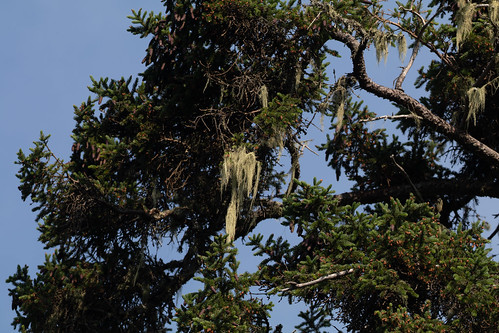(Transcript of podcast/radio program for June 25. You can listen to it [with many of the bird sounds] here.)
On Saturday, I was a leader on a hike along the Superior Hiking Trail sponsored by Northeastern Minnesotans for Wilderness. We started at the parking area at the Oberg Mountain entrance up by Tofte, and hiked a little more than a mile up the Leveax Mt. Trail and then back down again. We’d lucked into a perfect June day, both weather-wise and bird-wise. As always happens when hiking in a wonderful forest in June, birds were much more heard than seen, but one of the first things we saw, from the parking lot, was a Cedar Waxwing on a nest—that was a thrill.
Lots of birds were singing, especially Red-eyed Vireos and Ovenbirds, with enough American Redstarts, Blackburnian Warblers, and Black-throated Green Warblers to provide steady diversions. We had several wonderful moments, even though they were mostly auditory. Best for me were a Black-throated Blue Warbler and a Scarlet Tanager who stayed hidden but sang at fairly close range. Then just before we made it back to the parking lot, we heard a distant Wood Thrush. We’re at the extreme northern edge of Wood Thrush range, and so this bird was completely unexpected. I talked to Grand Marais’s bird guru Molly Hoffman at lunch, and she said she had documented several Wood Thrushes in the area over the years. I recorded the song with my iPhone for eBird.
We heard three Canada Warblers, one so close he was maybe even close enough to touch for a moment—but we could not pick out the little guy in the dense understory. A couple of distant Pileated Woodpeckers yelled and drummed, and we came very close to a third. We could hear soft pecking and scrutinized the dead tree—a couple of people got a good look, but most of us didn’t see it until it took off. Even a quick view of a Pileated is something I never tire of even though they’re a regular backyard bird for me.
On the other end of the size spectrum, we got great looks at a couple of tiny Golden-crowned Kinglets. One searched the ground at the base of trees for bugs; then he hovered at a spider web and a couple of branch tips, plucking out almost invisible insects, close enough that I could hear its high frequency call notes. Even with my hearing aids set on the special program my audiologist made to help me hear birds, I can only pick out the closest Golden-crowned Kinglets.
We heard one distant chickadee—they’re too busy stuffing food into nestlings right now to waste time chickadee-dee-dee-ing. Indeed, there were far, far more birds present than what we saw or heard. A few species don’t bother to sing at all now, and a great many limit song production to the dawn chorus, when all the forest creatures tune in for news of who made it through the night. Most territorial squabbles have been worked out weeks ago, and most birds who want a mate have found one. Baby birds of some species must hear their father singing to acquire their own song, so there will be a resurgence of song as babies get more self sufficient.
If you want to hear the wonderful warblers and other songbirds that make our north woods among the most diverse areas in all of the US and Canada, take a morning walk in the next two or three weeks. You’ll hear mostly Red-eyed Vireos and Ovenbirds, with others piping in occasionally. As summer progresses, even the dawn chorus will end. The Ovenbird will stick it out longer than the others. As Robert Frost wrote:
There is a singer everyone has heard,Here's the eBird list of all the birds we encountered (by sound or sight):
Loud, a mid-summer and a mid-wood bird,
Who makes the solid tree trunks sound again.
He says that leaves are old and that for flowers
Mid-summer is to spring as one to ten.
He says the early petal-fall is past
When pear and cherry bloom went down in showers
On sunny days a moment overcast;
And comes that other fall we name the fall.
He says the highway dust is over all.
The bird would cease and be as other birds
But that he knows in singing not to sing.
The question that he frames in all but words
Is what to make of a diminished thing.
31 species
Downy Woodpecker (Picoides pubescens) 1We also saw quite a few lovely plants, but I only focused on a few (with my Canon 100-400 lens):
Pileated Woodpecker (Dryocopus pileatus) 3
Least Flycatcher (Empidonax minimus) 2
Red-eyed Vireo (Vireo olivaceus) 7
Black-capped Chickadee (Poecile atricapillus) 1
Red-breasted Nuthatch (Sitta canadensis) 1
Golden-crowned Kinglet (Regulus satrapa) 2
Ruby-crowned Kinglet (Regulus calendula) 1
Veery (Catharus fuscescens) 3
Swainson's Thrush (Catharus ustulatus) 2
Hermit Thrush (Catharus guttatus) 1
Wood Thrush (Hylocichla mustelina) 1 We did not see this bird, but heard it. I recorded it with my iPhone.
American Robin (Turdus migratorius) 4
Cedar Waxwing (Bombycilla cedrorum) 3
Ovenbird (Seiurus aurocapilla) 8
Nashville Warbler (Oreothlypis ruficapilla) 1
Mourning Warbler (Geothlypis philadelphia) 1
Common Yellowthroat (Geothlypis trichas) 1
American Redstart (Setophaga ruticilla) 6
Northern Parula (Setophaga americana) 2
Magnolia Warbler (Setophaga magnolia) 1
Blackburnian Warbler (Setophaga fusca) 6
Chestnut-sided Warbler (Setophaga pensylvanica) 4
Black-throated Blue Warbler (Setophaga caerulescens) 1
Yellow-rumped Warbler (Setophaga coronata) 1
Black-throated Green Warbler (Setophaga virens) 5
Canada Warbler (Cardellina canadensis) 3
White-throated Sparrow (Zonotrichia albicollis) 3
Scarlet Tanager (Piranga olivacea) 1
Rose-breasted Grosbeak (Pheucticus ludovicianus) 4
Purple Finch (Haemorhous purpureus) 1





